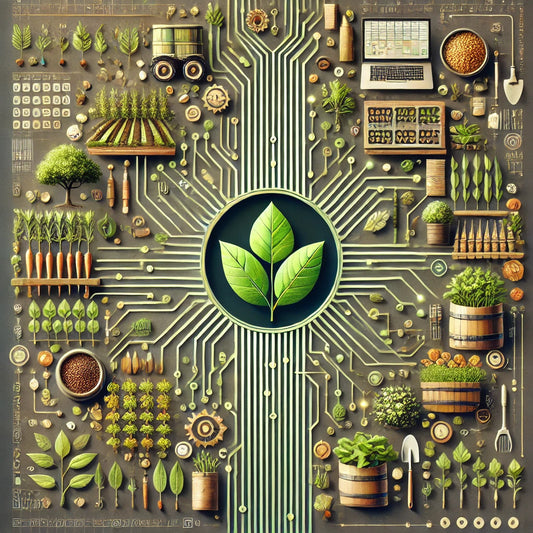
The Texas Local Food Directory - Category 10: Sustainable Practices and Regenerative Farming – Cultivating Resilience
The Texas Local Food Directory - Category 10: Sustainable Practices and Regenerative Farming – Cultivating Resilience
The Trees Before Sands master plan anchors 1001 acres in Irving, Texas, as a regenerative urban agriculture model blending interfaith collaboration, ecosystem restoration, robotics, and community food equity.
While Phase 1 builds the foundation, Phases 2 and 3 expand our influence through:
Interfaith garden propagation
Advanced agri-tech, aquaponics, and robotics labs
Urban food sovereignty hubs across DFW and beyond
This document outlines the strategic rationale, impact frameworks, and projected ROI for scaling this system as a national and global model.
Each of the 12 original churches in Phase 1 will mentor and seed 10 satellite orchard projects, reaching:
120+ satellite faith gardens across DFW
Additional 5,000+ acres converted into orchards, permaculture plots, and community-led grow spaces
🔁 Secondary Outcomes:
1M+ lbs of additional fruit/year from satellite orchards
200K+ residents gain access to fresh food
Faith-based curriculum taught in schools and mosques
Job training in permaculture, food distribution, and greenhouse operations
From your slides, we activate the “Thing Thing” robotic system and launch:
Agri-Robotics Testbeds in both schools (100 acres total)
Aquaponics Labs using closed-loop fish and vegetable systems
Vertical farming workshops led by youth and civic groups
📈 ROI Streams:
30% increase in productivity per sq ft via aquaponics
Up to $500K/year saved in water usage due to recirculation
Licensing and training programs can generate $1M+ revenue/year
R&D sponsorships from universities and sustainability funds (NSF, USDA, etc.)
Using your Gardeners of Eden app and Urban Garden Party, we:
Track fruit yields, community XP, and participation
Coordinate volunteer networks and harvest cycles
Offer virtual garden design (AR-based) and planting guides
📊 KPIs from Phase 2:
| Metric | Target |
|---|---|
| New Grow Hubs | 1,000+ |
| Seed Kits Distributed | 1,000,000 |
| XP-Tracked Volunteers | 10,000+ |
| School-Linked Gardens | 100+ campuses |
| Data Nodes via App | 50,000 |
Trees Before Sands — Timeline, Categories, Costs & ROI
| Phase | Timeline | Category | Activity | Estimated Cost (USD) | Expected ROI / Impact |
|---|---|---|---|---|---|
| Phase 1 | 2025 Q1–Q2 | Site Prep | Land clearance, road/path layout, utility setup | $5,000,000 | Foundational setup completed |
| Phase 1 | 2025 Q2–Q4 | Planting & Infrastructure | Tree planting (100,000+), shed construction, school build-out | $20,000,000 | $92M produce over 5 years |
| Phase 1 | 2026 | Education & Training | Train local workforce, hire educators, launch Eden curriculum | $5,000,000 | 10,000+ students trained |
| Phase 1 | 2026 | Market Setup | Launch sheds, establish market rotation and vendor system | $3,000,000 | $3M/year in market activity |
| Phase 1 | 2026–2027 | Monitoring & Reporting | Carbon tracking, XP logs, impact dashboards | $1,000,000 | Transparency, grant eligibility |
| Phase 2 | 2027–2028 | Faith Garden Expansion | Mentorship from 12 churches to plant 120+ satellite gardens | $2,500,000 | 1M+ lbs of new fruit/year |
| Phase 2 | 2027–2028 | Robotics & AgriTech | Launch aquaponics labs, robotics integration, STEM programs | $4,000,000 | $1M/year tech income |
| Phase 2 | 2027–2028 | App Deployment | Release Grower app, Eden Access Card system, live dashboard | $1,500,000 | 50,000 users XP tracked |
| Phase 2 | 2028 | Policy & Partnerships | Engage with USDA, state departments, school districts | $1,000,000 | Govt/foundation funding unlocked |
| Phase 3 | 2029 | Eden Charter Launch | Release Eden Charter, open-source toolkit, interfaith covenant | $250,000 | Civic adoption + faith alignment |
| Phase 3 | 2029–2030 | Global Replication | Replicate in 30+ cities worldwide using toolkit | $3,000,000 | Replication revenue & grants |
| Phase 3 | 2030 | Ecosystem Mapping | Geospatial food forest overlays, global Eden index mapping | $1,000,000 | Global Eden maps live |
| Phase 3 | 2030+ | Long-Term ROI | Net food output, carbon offset, job data reported globally | $500,000 | Global impact, $500M+ value creation |
Capital Expenditure:
Annual Operating & Maintenance Costs:
Primary Produce Sales:
Secondary Income (12 Sheds):
Aggregate Annual Revenue:
When combining direct financial returns with social, educational, and environmental multipliers, the overall ROI for a city can be significantly higher than the direct profit margin:
Note: These figures are based on estimated assumptions and modeled projections. Actual outcomes will depend on factors such as market conditions, effective management, community engagement, and unforeseen operational challenges.
A city investing in a 1001-acre regenerative food forest integrated with academic and community programs could see substantial returns—not just in direct financial profits, but also through enhanced social cohesion, improved public health, and long-term environmental sustainability. By leveraging local assets and fostering interfaith and educational collaborations, the project stands to transform urban agriculture into a powerful engine for economic and community development.
This comprehensive, multi-layered approach makes it not only a profitable venture but also a model for resilient, sustainable urban futures.